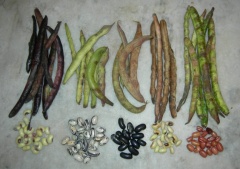Cowpeas
| Infobox on Cowpeas | |
|---|---|
| Example of Cowpeas |  |
| Facts | |
| Origin | Africa, Asia, C/S America |
| Stowage factor (in m3/t) | 1,4 m3/t |
| Angle of repose | - |
| Humidity / moisture | - |
| Oil content | - |
| Ventilation | - |
| Risk factors | - |
Cowpeas
Description
Cowpeas are one of the most important food legume crops in the semi-arid tropics covering Asia, Africa, southern Europe and Central and South America. A drought-tolerant and warm-weather crop, cowpeas are well-adapted to the drier regions of the tropics, where other food legumes do not perform well.
It also has the useful ability to fix atmospheric nitrogen through its root nodules, and it grows well in poor soils with more than 85% sand and with less than 0.2% organic matter and low levels of phosphorus. In addition, it is shade tolerant, and therefore, compatible as an intercrop with maize, millet, sorghum, sugarcane, and cotton.
Cowpeas are a common food item in the southern United States, where they are often called field peas. Two subcategories of field peas are crowder peas, so called because they are crowded together in their pods, causing them to have squarish ends, and cream peas.
According to the USDA food database, cowpeas have the highest percentage of calories from protein among vegetarian foods.
Wordwide cowpea production has increased dramatically in the last 25 years. United States production of dry cowpea has declined from 3/4 million acres to a few thousand over the same period. The blackeyed cowpea type is grown primarily in California and is marketed as California blackeyed peas.
Uses:
Cowpea seed is a nutritious component in the human diet, as well as a nutritious livestock feed. Nutrient content of cowpea seed is summarized in Table 1.
Nutrient content of mature cowpea seed (average of eight varieties).
| Protein | 24.8% |
| Fat | 1.9% |
| Fibre | 6,3% |
| Carbohydrate | 63.6% |
| Thiamine | 0.00074% |
| Riboflavin | 0.00042% |
| Niacin | 0.00281% |
The protein in cowpea seed is rich in the amino acids, lysine and tryptophan, compared to cereal grains; however, it is deficient in methionine and cystine when compared to animal proteins. Therefore, cowpea seed is valued as a nutritional supplement to cereals and an extender of animal proteins.
Cowpea can be used at all stages of growth as a vegetable crop. The tender green leaves are an important food source in Africa and are prepared as a pot herb, like spinach. Immature snapped pods are used in the same way as snapbeans, often being mixed with other foods. Green cowpea seeds are boiled as a fresh vegetable, or may be canned or frozen. Dry mature seeds are also suitable for boiling and canning.
In many areas of the world, the cowpea is the only available high quality legume hay for livestock feed. Digestibility and yield of certain cultivars have been shown to be comparable to alfalfa. Cowpea may be used green or as dry fodder. It also is used as a green manure crop, a nitrogen fixing crop, or for erosion control. Similar to other grain legumes, cowpea contains trypsin inhibitors which limit protein utilization.
Shipment / Storage / Risk factors
As a rule cowpeas is vermin infected.
Other cargoes stowed nearby are very likely to get contaminated.
For further transport aspects see Beans, dried











